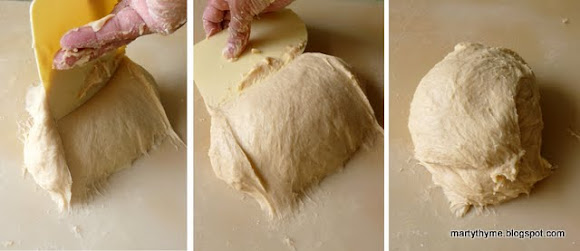| BALLERINAS IN TUTUS: BRIOCHE À TÊTE |
At the other end of the brioche butter scale is brioche très commune (very common). This bread contains only 25% butter. I came upon Flour, Water and Yeast (I think this is an excellent blog about breadmaking) and blogger Nina also finds the liberal use of butter in brioche too much. (Gosh, it's weird to see myself write that something has too much butter.) She uses this recipe for a poor man's version of brioche. I tried the recipe, with some modifications.
I made brioche à tête (or Parisian brioche) as I recently got a set of individual fluted loaf tins. It has that classic topknot that looks like a head. Brioche de Nanterre (a city west of Paris) is another classic form. The dough is rolled into small balls and arranged in two rows in a loaf tin. This is termed as (wait for it...) parallelepipedic (another snippet courtesy of the late great Alan Davidson).
This brioche dough is not only soft but buttery as well, even with the reduced amount of butter in this recipe. Now, I am no expert in kneading but I have developed my own techniques, and the pictures below show how I knead soft dough. I don't know if this is the correct way to do it, but it works for me. A stand mixer and dough hook would do the job for a large amount of dough, but I usually only make small batches which means it's a waste of time and effort to get the machine out.
For the poor man's brioche, I start out by combining the dry ingredients:
250g all-purpose flour
2 tablespoons full-cream milk powder
¾ teaspoon salt
1 teaspoon active dry yeast, and
1 teaspoon caster sugar.
Then I add:
1 medium egg plus 1 egg white (reserve the yolk for glazing the brioche before baking)
¾ teaspoon pure vanilla extract, and
enough tepid water (about 90ml) to combine the dry and wet ingredients to form a soft, but clumpy dough.
I then place the dough on the work surface, cover it with a mixing bowl and leave for 10 minutes to rest.
A note on the vanilla extract: If I didn't have pure vanilla extract, I would just leave it out. Imitation vanilla essence is just not worth it. I used a Mexican variety, which is quite lovely. Inhaling the aroma during the kneading process was wonderful. Very calming!
After the dough has had a brief sitting time, it needs to be kneaded before butter is added. I try not to add any extra flour as that would ruin the balance. Instead, I use a plastic dough scraper to stretch and fold the dough, and this is best done on a marble surface. Here's the process in pictures:
 |
| S-t-r-e-t-c-h the dough... |
 |
| ...and fold it over itself several times with a plastic scraper until smooth |
Place the ball in a bowl and cover with cling film. Leave to rest for 30 minutes, or until slightly puffy, then refrigerate overnight. Note that the resting time is, of course, based on room temperature. At a temperature of 28°C (82°F), it takes 10-15 minutes to start rising.
Meanwhile, preheat the oven to 180°C. When the brioche have risen, bake until golden, about 15 minutes. Set on a wire rack to cool, 5 minutes, then remove from moulds.
The verdict: The egg wash produces a crisp crust. The crumb is tight but springy. I think a good brioche should be lighter. In terms of richness, it is as expected. The small amount of egg and butter make it a good white bread, but it certainly wouldn't pass muster with any prince. This is definitely a poor man's brioche.
Actually, I think spreading butter on the less rich brioche is a better use of butter. As a spread, I can use best-quality butter (always more expensive), something I wouldn't use for the dough.

Looks fluffy! I love it since this is much healthier:)
ReplyDelete